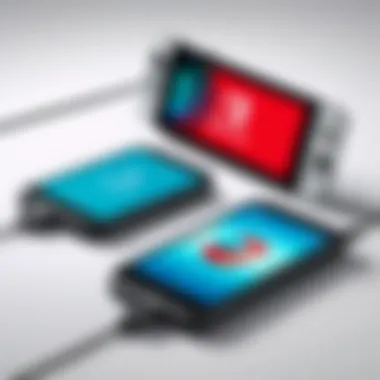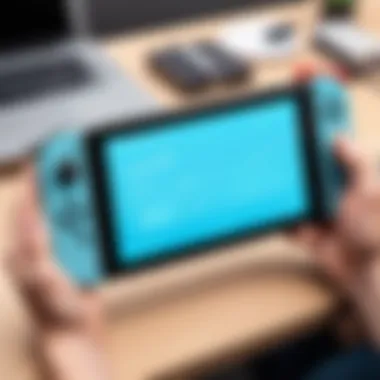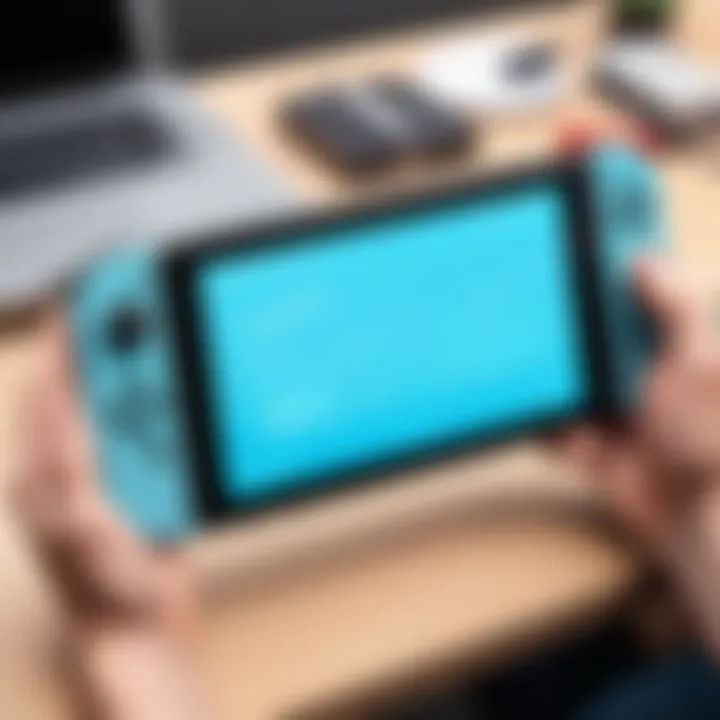Transfer Videos from Nintendo Switch to Smartphone


Intro
In today’s digital age, sharing and transferring media has become a seamless part of our lives. When it comes to the Nintendo Switch, a popular console among gamers, transferring videos to a smartphone can seem like a daunting task. With content creators burgeoning on platforms like TikTok and Instagram, knowing how to share your in-game moments can really set you apart.
In this guide, we’ll look at various methods to effortlessly transfer videos from your Nintendo Switch to your smartphone. Whether you're aiming to share gameplay highlights or tutorials, we’ll break everything down for you, step by step.
From using direct connections to exploring third-party apps and even cloud-based solutions, we aim to evaluate the effectiveness and ease of each method. We’ll also dive into potential limitations you might encounter along the way, ensuring that you pick the right approach based on your comfort level and tech proficiency.
Let’s make the transfer process as smooth as butter!
Understanding the Video Transfer Landscape
Navigating the world of video transfers between devices, particularly from a Nintendo Switch to a smartphone, necessitates a solid grasp of the available methods and their nuances. In an age where content creation and sharing have achieved immense prominence, understanding the landscape of video transfer is pivotal. The significance lies not just in the act of moving files, but in ensuring that the process is streamlined, efficient, and effective.
The Popularity of Video Sharing
Video sharing has easily become a lynchpin of social interaction and communication today. With platforms such as YouTube, TikTok, and Instagram, it’s no surprise that creating and disseminating content is more accessible than ever. Many gamers, for instance, take delight in showcasing their gameplay highlights or those unexpected comedic moments that come alive during gaming sessions. This desire to share experiences has transformed video sharing from a niche hobby to a widespread cultural phenomenon.
In this context, transferring videos from the Nintendo Switch has gained traction. Gamers find it essential not only for personal enjoyment but also for connecting with like-minded individuals. According to recent statistics, approximately 70% of gamers indulge in sharing their gameplay via various platforms, underlining the importance of facilitating easy transfer solutions.
"Video is the next best thing to being there in real time, it's a window into experiences that we all want to share."
Why Transfer Videos?
The reasons behind transferring videos from a gaming device to a smartphone encompass several dimensions. For one, it allows users to edit and enhance videos using powerful mobile applications before posting them on social media. This gives a personal touch and polish to raw gaming clips, making them visually appealing and engaging.
Moreover, smartphones are relatively lightweight and portable, making them more convenient for sharing on the go. By having the video files stored on a smartphone, users can boast about their achievements among friends or across social media platforms at a moment's notice.
To sum it up, the transfer process not only satisfies creative urges but also enhances social interactions in an increasingly digital world. It propels community engagements among gamers, influencers, and content creators, fostering a vibrant ecosystem. Therefore, understanding the video transfer landscape is not just beneficial; it's essential for anyone looking to maximize their gaming experience.
Preparation for Video Transfer
Before diving into the actual video transfer processes from a Nintendo Switch to a smartphone, it’s essential to understand the significance of proper preparation. In this case, preparation is the foundation that ensures a smooth and efficient transfer experience. Without the right setup, users may face unnecessary complications, frustration, and even data loss. Hence, laying the groundwork helps in avoiding potential pitfalls that could distract from the enjoyment of sharing game highlights with friends or family.
A well-prepared setup also allows users to familiarize themselves with the necessary equipment and tools, as well as the steps they’ll need to take. By being aware of what lies ahead, users can navigate the transfer process like a breeze. The benefits here are not just about speed; it’s also about accuracy and the satisfaction that comes with success.
Necessary Equipment and Tools
When embarking on the journey of video transfer, having the right equipment is key. Here’s a rundown of what you’ll need:
- Nintendo Switch 🔄: Obviously, you need the console itself, preferably one with videos saved in the album.
- Smartphone 📱: A device compatible for receiving files, which can be an Android or an iPhone, depending on personal preference.
- Cables 🔌: If you decide on a direct USB transfer, a USB-C cable is a must. This cable links your Nintendo Switch to your computer or smartphone.
- MicroSD Card 💾: A tool for those who opt to transfer files via a card, ensuring larger storage capacity if needed. Ensure compatibility for your devices.
- Computer 💻: This can come in handy for managing files, especially during the direct transfer method.
- Apps ⬇️: Depending on the chosen method, installing specified applications that facilitate the transfer can streamline the process.
These elements will make up the toolkit every user should have at their disposal. Having each item ready can greatly ease the transfer process.
Setting Up Your Devices
Once you have gathered the necessary equipment, the next step is to set up the devices involved. This is where ensuring that everything is correctly configured is pivotal. Preparations might seem mundane, but trust me, they can save a bunch of headaches later on.
- Charge Your Devices 🔋: Making sure that both the Nintendo Switch and smartphone are charged is a crucial first step. You wouldn’t want to run out of battery halfway through the transfer.
- Update Software ⬆️: Check that your Nintendo Switch and smartphone have the latest updates. Compatibility issues often arise from outdated software, so this step is crucial for maximizing efficiency.
- Install Necessary Applications 📥: If you choose to utilize third-party applications or cloud services, make sure these apps are installed on your smartphone. Take a moment to familiarize yourself with how they function, as user interfaces can vary widely.
- Backup Your Data 💾: Before proceeding with any method, it’s wise to back up both your gaming console and phone data. This way, if something goes awry, your precious moments are protected.
- Create a Transfer Plan 📝: Think about which method you prefer. Are you going USB, microSD, or cloud? Having a clear plan helps in following throughout the transfer process.
Taking these preparatory actions not only sets the stage for successful transfers but also boosts confidence in handling potential issues that might arise. Remember the adage, "An ounce of prevention is worth a pound of cure." Putting in the time to prepare adequately can lead to a seamless video transferring experience.
Methods for Transferring Videos
As users of the Nintendo Switch become more enthusiastic about sharing their gaming experiences, the demand for straightforward transfer methods has increased. Knowing how to transfer videos efficiently from your Nintendo Switch to your smartphone is crucial, not just for storage purposes but also for sharing memorable gaming moments with friends or on social media. In this section, we will explore several methods you can employ, from direct connections to utilizing cloud solutions. Each method has its own blend of benefits and considerations — choosing the right one can make all the difference in your video transfer experience.
Direct Data Transfer via USB
Transferring videos directly through the USB connection between your Nintendo Switch and smartphone is perhaps the most straightforward approach. This method provides a fast and reliable connection, often resulting in quicker transfer speeds than other methods. When you connect the two devices, the smartphone will recognize the Switch’s storage, allowing you to navigate through the files easily.


However, keep in mind that some smartphone models may require specific drivers or settings adjustments to recognize the Switch. If that’s the case, be sure to research or consult your device's user manual. This direct method works well if you're in a hurry and need to transfer a handful of videos without complications. Always ensure to have the right cable ready, because not all USB cables will work seamlessly, particularly if they aren't for data transfer.
Using MicroSD Card
Many Switch users prefer to utilize a MicroSD card for transferring videos. This approach involves removing the card from the Switch and plugging it into a card reader connected to your smartphone or computer. It's a unique advantage that allows you to offload videos without needing to connect devices directly.
The basic steps include:
- Inserting the MicroSD Card: Power down your Switch before removing the card to prevent any corruption.
- Transferring Files to Computer: Once you’ve inserted the card into your computer, navigate to the designated folder containing your videos.
- Final Transfer to Smartphone: This step involves either dragging files to your phone directly or using another method like USB or cloud storage afterwards.
Using a MicroSD card might seem a bit cumbersome at times, but for users with many videos, it allows for large amounts of data to be transferred at once, making it a practical option.
Third-Party Applications
Another widely-used method for transferring videos involves third-party applications designed specifically for this purpose. Apps like Shareit or Xender can be downloaded on both your Nintendo Switch (if permitted, usually via homebrew) and smartphone. These applications use Wi-Fi to create a local network between your devices, facilitating faster transfer than conventional Bluetooth connections.
While these apps often boast seamless transfers, they can also introduce some hurdles, like reliability issues or ads. Choosing a reputable app with strong user reviews can help alleviate these concerns. Also, keep your device updated to ensure compatibility and a smooth operation.
Cloud Storage Solutions
Google Drive
Google Drive stands out as a popular solution for transferring videos due to its user-friendly interface and seamless integration with mobile devices and PCs. Once files are uploaded to Google Drive from your Nintendo Switch via your computer, accessing them from your smartphone is just a matter of downloading the app and logging in. The key characteristic of Google Drive is its generous free storage allocation, which often makes it a go-to for many.
However, users should note that the upload and download speeds can vary based on internet connectivity, and larger video files may take longer to process through the cloud, especially if you have a slow connection. One significant advantage is that your files remain backed up in the cloud, making it a reliable choice for regular users.
Dropbox
Dropbox simplifies file transfers while also allowing for shared access to videos. It’s akin to Google Drive but offers more advanced sharing features for collaborative projects or joint gaming memories. Dropbox is often favored for its clean interface and ease of use. It also provides cross-platform compatibility, allowing smooth access from both the Switch and smartphone without hiccups.
However, users should consider storage limits since Dropbox’s free tier offers less space compared to Google Drive, which may be a deterrent for those with many video files. The unique feature here is its ability to create shared links, enabling friends and family to access videos straight from their devices without requiring an account.
OneDrive
OneDrive is Microsoft's cloud storage solution, making it particularly appealing for users in the Windows ecosystem. With OneDrive, the integration with Windows is remarkably smooth, allowing users to transfer videos to their smartphone with relative ease. The key characteristic of OneDrive is its seamless collaboration capabilities, especially within Microsoft Office apps.
Nonetheless, users should note that OneDrive does offer less free storage compared to its counterparts and files might be subject to different formats upon upload. An attractive feature is its ability to restore deleted files within a certain timeframe, adding an extra layer of security for those who work with many different files.
Always remember to regularly check your storage limits and account settings in these cloud solutions to ensure your video transfers are smooth and uninterrupted.
Step-by-Step Instructions for Each Method
Navigating the world of transferring videos from a Nintendo Switch to a smartphone is like learning to ride a bike. At first, it may seem daunting, but with a little guidance and practice, it quickly becomes second nature. The step-by-step instructions provided in this section are essential, as they offer clear guidance on the methods that can be employed, ensuring that both novice and more adept users can partake in the transfer process without a hitch. By breaking down the procedures into manageable parts, users can easily follow along and verify their progress.
Direct Transfer via USB
Connecting Devices
When it comes to connecting devices, think of it as linking two friends for a quick chat. You need the right interface, and that's where a USB cable comes in. This method is favored due to its speed and reliability. Simply plug one end of the USB cable into your Nintendo Switch and the other into your smartphone or computer. One crucial characteristic to note is that this method often requires no additional software, making it particularly user-friendly. However, keep in mind that while many smartphones support direct USB connections, you might encounter compatibility quirks, especially with older devices. It's like inviting someone to a party who doesn’t quite fit in.
File Management
After the devices are connected, file management begins in earnest. Think of this as tending to a garden: you need to know what to plant. Here, you'll access the video files stored on your Nintendo Switch. The key aspect is knowing exactly where files are located and how to transfer select files to your device. It's a systematic process that requires attention to detail. While this method gives you more control over which files to transfer, the downside is that it may feel tedious, especially if you have numerous videos. The balance here is between thoroughness and efficiency—it's like carrying the perfect mix of gears for a hike.
Troubleshooting Common Issues
There’s that saying, "better safe than sorry." With technology in play, you'll want to predict and handle problems before they arise. Common issues could range from cable incompatibility to device recognition problems. Knowing how to troubleshoot can save you a world of frustration and ensure a smooth transfer.
If you run into snags, steps like trying different USB ports or checking device settings are useful initial moves. Understanding these potential pitfalls not only prepares you for the transfer process but also equips you with skills for future tech adventures.
Transferring with MicroSD Card


Inserting the MicroSD Card
Inserting the MicroSD card is akin to placing an envelope in a mailbox—simple if you're familiar with the flow. First, ensure that the MicroSD card is properly formatted and inserted into the Nintendo Switch. This process is vital because, without proper installation, transferring files becomes a chore rather than a breeze. Proper insertion prevents errors during the transfer and protects the card itself. Keeping the card in a slot that is snug yet accessible is a huge benefit for easy management and avoids possible data corruption, which is an unwanted headache.
Transferring Files to Computer
Once the card is snugly fitted in your device, it’s time to move your clips onto your computer. Picture this step as ferrying goods across a river: you need a solid boat (or in this case, your file management software) to get to the other side safely. By utilizing a card reader connected to your computer, you can quickly drag and drop your video files onto the desired folder. While this method offers clear visibility into file structures, it can be tricky if you're unfamiliar with navigating folders. Users must stay organized to avoid confusion. Plus, having backups is smart in this digital age; nobody wants to lose their prized footage.
Final Transfer to Smartphone
The last leg of this journey takes place when you transfer those files from the computer to your smartphone. Think of it as sending a message: you want it to land in the right inbox. This part is crucial for ensuring your videos are ready for viewing on the go. Using a USB cable or cloud services makes this process seamless. Although it's an effective method, transferring large files can be a test of patience, especially if using a slower connection. While it feels like crossing the finish line, you may have to grapple with transfer times that vary depending on the file size and type.
Using Third-Party Apps
Recommended Applications
Diving into the world of apps opens up an avenue for easier solutions. Applications such as SHAREit or Send Anywhere allow for quick transfers without the hassle of wires. The remarkable feature here is cross-platform capability. This means you’re not limited by device types, which is a key characteristic that many find appealing. These apps also tend to have user-friendly interfaces, making the process accessible for tech novices. On the flip side, users should keep in mind that app performance can vary, and some may require a learning curve.
Installation Process
Installing any app involves a straightforward process. After selecting the right one, it takes just a few taps, but diligence is essential. Ensure you download legitimate applications to sidestep any potential security risks. One benefit of many of these apps is that they frequently come with tutorials or support, guiding you through the initial complexities. However, relying solely on an app could lead to problems if your internet connection falters or the app faces unexpected bugs, so having a backup method is wise.
Transfer Procedure
Once the app is installed, following its specific transfer protocol is where the excitement kicks in. Users often can transfer files over Wi-Fi direct or Bluetooth, which eliminates cable mess. This not only speeds up transfers but also adds a layer of convenience. Still, one potential limitation here is that users may find app sizes outstrip actual content if they don’t manage storage effectively from time to time.
Uploading to Cloud Storage
Uploading from the Nintendo Switch
Loading your videos to cloud storage from the Nintendo Switch is like saving a rainy day fund—you're securing your content for future access. Many users appreciate this method because it allows for flexibility in access. By simply uploading your videos through the Nintendo Switch’s settings, you ensure that your creations are safe and sound. The downside to consider here is that slow internet could stretch the process out far longer than anticipated, leaving you with those anxious moments of waiting.
Accessing Files on Smartphone
With the cloud serving as a digital locker, getting your files on your smartphone is just a few taps away. Navigating through your preferred cloud app allows swift access to your videos. This method gives users instant access to their content anytime, anywhere. However, make sure you have reliable internet to avoid headaches while trying to download. The most beneficial aspect to note is the ease of synchronization across devices, although some may trip over data limits set by their cloud service, so keep an eye on your storage usage.
Best Practices for Cloud Transfers
When it comes to utilizing the cloud, there's a smart way to go about it. Best practices include ensuring your files are properly organized within the cloud service and regularly checking for updates to minimize any service interruptions during transfers. Proper organization saves you from future headaches when trying to retrieve items quickly. These practices enhance efficiency, and while the process is generally smooth, users could feel overwhelmed by the variety of cloud services available, making it crucial to select one that aligns with their needs. 🔑
Always back up your data with a reliable method. The last thing you want is to face data loss after a long day of shooting videos from your Nintendo Switch.
Employing these methods with proper knowledge and execution can help navigate the otherwise tricky waters of video transfers, allowing you to keep your prized clips at your fingertips.
Common Challenges in Video Transfers
Transferring videos from your Nintendo Switch to a smartphone can seem pretty straightforward, but often it does come with its own set of hiccups. Understanding these common challenges is important so that you can sidestep any potential issues before they even pop up. Each of these problems can affect the ease and quality of the transfer, which is crucial for those who want their game highlights or cherished moments to turn out just right. By being aware of these challenges and the steps needed to navigate them, you'll be better equipped to manage your video transfers efficiently.
File Format Compatibility Issues
One of the first hurdles that crops up in video transfers is file format compatibility. The Nintendo Switch tends to save videos in a specific format, typically MP4. Meanwhile, not all smartphones support this format or may require additional software to play them back properly. If your phone's video player doesn't recognize the format, you could wind up with a beautifully captured clip that you can’t actually watch.
To avoid this, it's wise to check into the formats supported by your smartphone before starting the transfer. If your phone struggles with MP4, you might need to convert the video after transferring it to your computer and before moving it to your phone. Thus, using a versatile video converter like HandBrake can be beneficial in such cases. Not only does it support multiple formats, but it also allows for high-quality conversions, making it easier to access your content seamlessly down the line.
Connectivity Problems
Connectivity can be another thorny issue when pulling videos over. You might be using a USB connection, Bluetooth, or even a cloud service. In any case, interruptions can lead to incomplete transfers or corrupted files.
For example, if you’re trying to connect your devices via USB but there's a faulty cable or loose connection, the transfer can be halted unexpectedly. To mitigate such issues, always make sure to use a reliable cable and inspect the ports. If you notice anything stale, it might be worthwhile to invest in a quality replacement. Additionally, checking your internet connection stability when using a cloud service is essential, as unpredictable connections could throw a wrench in your upload times or create setbacks.


Data Loss Situations
Finally, let’s not overlook the dreaded data loss situation. Imagine all your hard work recording gameplay or memorable moments, only for something to go awry during the transfer process. This can happen for various reasons, including sudden power outages, disconnected devices, or even failing software.
To safeguard against these risks, regularly back up your data on multiple platforms. Use a combination of local storage (like a computer or an external hard drive) and cloud services. By doing so, even if one avenue fails, you’ve still got your precious video files elsewhere. Trusting only one method is akin to putting all your eggs in a single basket—something we all want to avoid in this tech age.
"Always have a backup plan; in tech, it’s not a matter of if something goes wrong, but when."
In summary, while transferring videos from your Nintendo Switch to smartphone might seem like a walk in the park, mindful navigation through these challenges can save you a lot of time and headaches. Keeping an eye on file compatibility, ensuring a solid connection, and preparing for data loss are key to smooth sailing through the transfer process.
Post-Transfer Considerations
After the transfer process is done, it’s vital to consider what happens next. While successfully moving videos from a Nintendo Switch to a smartphone is an achievement in itself, managing those files effectively and sharing them appropriately ensures you get the most out of your new digital content. Ignoring these aspects can lead to disorganization, file loss, or a missed opportunity to share great moments with others.
Many users can feel a sense of relief after completing the transfer; however, without a plan, it’s like having a treasure map but never digging up the chest. You must take the next steps to really capitalize on what you’ve achieved. Let’s break this down into two key areas: managing video files and sharing them.
Managing Video Files on Smartphone
Managing your video files can be quite the task. After transferring, you may find a jumble of recordings scattered across your phone. Start by creating a dedicated folder in your smartphone’s file management system. This not only helps you find your videos easier, but it also keeps irrelevant files from getting mixed up with your prized captures from gaming sessions.
Some tips for efficient file management include:
- Organize by Game: Create subfolders for different games. This helps if your Nintendo Switch has a lot of content. It’s like your own mini library.
- Rename Files Clearly: Instead of keeping default filenames, rename your videos to reflect their content, for instance, “Mario Kart Race Highlight” vs. “VIDEO_1234.” This makes it much easier to locate specific videos later.
- Backup Regularly: Utilize cloud services or external drives to create backups. Losing precious gaming memories is a heartbreaker.
- Quality Check: After transferring, make sure to watch your videos and ensure they transferred properly. Sometimes, file corruption can take place during the transfer process.
Taking the time to manage and organize your videos effectively contributes to a more enjoyable experience overall. A little effort can keep your collection neat and accessible.
Sharing Videos from Your Phone
Sharing videos opens a whole new world, allowing you to connect with friends and fellow gamers, and show off your best moments. Whether it’s for social media, group chats, or platforms like Reddit, sharing is what brings those gaming experiences to life.
Here’s how to proceed:
- Choose Your Platform: Decide where you want to share your videos. Social media channels, such as Facebook or Instagram, or perhaps gaming forums?
- Edit Pre-Share: Take a moment to edit your videos. There are several apps for smartphones that can help you trim clips, add effects, or even include music. Editing can elevate your video from basic to a captivating spectacle.
- Appropriate Permissions: Make sure to respect others’ privacy. If your video includes other players, get their consent before posting. It’s a commonly overlooked aspect and can cause unneeded drama.
- Engage with Your Audience: When sharing videos, write captions that entice your followers to watch the videos. Pose questions or invite feedback to create engagement.
- Check Quality Before Posting: Lastly, ensure the video quality is still good. Sometimes, a low-resolution video can detract from great content. A good rule of thumb is to check it on your phone first before sharing it out.
- Each platform often requires different file formats or dimensions, so have a look at these and adjust your videos accordingly.
Sharing should be fun, not stressful! Having a clear game plan on how you’re going to share your videos can lead to a better experience, both for you and the people your sharing them with.
"Remember, the best moments in gaming aren’t just played; they’re shared."
Ultimately, taking these post-transfer steps leverages your hard work during the actual transferring process, allowing you to bask in the achievements you recorded and shared with others.
Finale
The transfer of videos from a Nintendo Switch to a smartphone serves as a pivotal aspect for gamers who wish to share their gameplay moments with friends and family. In this article, we've dissected the various methods available for accomplishing this task, aiming to cater to diverse preferences and technical abilities. Understanding the necessity of this process opens the door to numerous opportunities for creativity and connection among users.
Summarizing Key Points
Throughout the guide, we have explored several essential methods of transferring videos, each with its own set of advantages and possible complications.
- Direct Data Transfer via USB offers a straightforward approach, requiring only the necessary cables and connections. However, the user must ensure compatibility and rectify any potential issues during the process.
- Utilizing a MicroSD Card not only provides considerable storage but also allows users to easily transfer files around by inserting the card into compatible devices. Still, users need to be cautious of formatting and file management, or they might find themselves in a pickle.
- The usage of Third-Party Applications presents an alternative method padded with innovative features, but could raise eyebrows with complications rooted in app reliability and privacy concerns.
- Lastly, Cloud Storage Solutions such as Google Drive and Dropbox streamlines sharing and accessibility; however, they also beckon users to consider their internet connection and data privacy issues carefully.
These varied methods cater to different needs, allowing users to pick a solution that aligns with how they intend to use their videos post-transfer.
Future of Video Transfers
As technology continues to advance, the landscape of video transfers is bound to evolve. The advent of higher-quality video recording capabilities in consoles like the Nintendo Switch, combined with increasing smartphone storage options, hints at a future where sharing high-definition gaming content becomes as seamless as pie. Advanced techniques such as direct streaming or even integrated apps could soon replace conventional file transfers altogether.
Moreover, the rise of 5G connectivity might propel the speed and effectiveness of transfers to unprecedented heights, making cloud services even more appealing due to reduced latency and buffer times.
In essence, as innovation unfolds, the process of transferring videos from console to device will likely be streamlined, giving tech enthusiasts and gamers alike an easier path to showcase their skills. Embracing these advancements will not only open new avenues for sharing but also redefine how we interact with gaming content.
"The future isn't just something we enter; it's something we create."
In summarizing the key points and anticipating the future of video transfers, it’s clear that understanding and mastering these techniques will empower users to make the most of their gaming experiences now and beyond. The sooner one gets familiar with these methods, the better equipped they'll be to embrace the fast-paced world of gaming technology.



